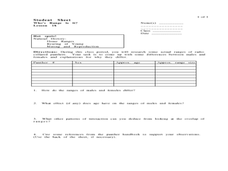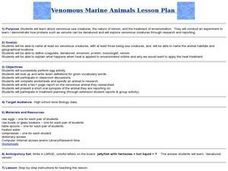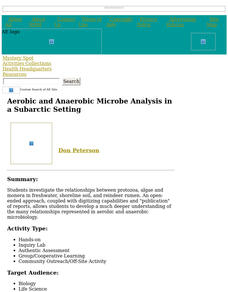Curated OER
Isopod Behavior, of the Rolly Polly Lab
Students investigate the behavior of isopods. In this isopod lesson plan, students make observations of an isopod and sketch the pillbug. They study the orientation of the isopods in relation to moisture in a chamber they construct from...
Curated OER
The Legendary Raptors
How are raptors and airplanes alike? Combine science and language arts in this fun and interactive project. Young scientists research the animal in order to design their own aircraft, and compete in a contest for farthest, fastest, and...
Curated OER
Hawaii's Freshwater Animals - Species Report
Students explore biology by creating a report for the class. In this oceanography lesson plan, students research and identify the survival characteristics of a list of freshwater animals by utilizing the Internet and library. Students...
CK-12 Foundation
Function Rules for Input-Output Tables: Function Machine!
Watch as a function machine converts an input to an output. Learners determine the work applied by the function machine to write a function rule. Questions accompany the function machine animation to guide individuals to conclusions.
Curated OER
What Makes a Cat a Cat?
Students investigate the lives of pets by videotaping them. In this animal life lesson, students videotape a cat and other pets using school cameras in a computer lab. Students review the footage from the cat and other...
Curated OER
Identification of Animals by Serum Electrophoresis
Students compare their unknown serum against a set of known serum standards and determine the animal source of their serum. They write a lab report to communicate their results.
Curated OER
Habitat Assessment
Third graders demonstrate the effects of varying environmental components on plants and animals: chemical, physical and biological characteristics of a habitat. They find chemical, physical and biological characteristics of the lake at...
Curated OER
Who's Range is it?
Students investigate the habits of panthers by analyzing radio transmitted data. In this animal life lesson, students utilize computers to view the range of different statistics dealing with Florida panthers. Students...
Curated OER
What Makes a Tropical Rainforest Special?
Students examine the characteristics of the tropical rainforest. Using a map, they locate the rainforests found around the world, continents and the equator. Using the internet, they research the various layers of the rainforest and...
Curated OER
Marine Life, Oceans, Lakes and Rivers
Students examine the types of organisms found in oceans. In groups, they read articles about the research done at certain sites. They work together to research their own water ecosystems and report the findings to the class. To end...
Curated OER
Elements of Biology: Organization In Living Systems
Students explore the recent research on dinosaurs. In this dinosaur lesson students write a report on the new findings and how it has changed ideas on dinosaurs.
Curated OER
Domain and Range 2
How do you identify the domain and range of the function? As learners find out it's as easy as creating a graph. They'll identify the domain and range of a relation from its graph, write symbolic expressions describing the relationship...
Curated OER
Agriculture Counts
Students discuss the kinds of things they count and how to use tally marks. In this social science instructional activity, students count animal crackers by using tally marks for each kind of animal. The tally marks are changed into...
Curated OER
The Desert Alphabet Book
Young scholars explore world geography by researching a science book with their classmates. In this desert identification lesson, students utilize a U.S. map to locate the geographical locations of deserts. Young scholars create an oral...
Curated OER
Venomous Marine Animals
High schoolers name and describe six venomous marine animals. After participating in an activity, they define new vocabulary words. In groups, they complete worksheets to use while researching a specific venomous animal of their...
Curated OER
Aerobic and Anaerobic Microbe Analysis in a Subarctic Setting
Students investigate the relationships between protozoa, algae and monera in freshwater, shoreline soil, and reindeer rumen. They publish reports of their findings.
Curated OER
Endangered Ecosystems Grades 4-5
Students read about research at the field sites. They read field reports from team members at the site. Students conduct their own research on ecosystems in their lives. They explore and build an interactive food web. Students create...
Curated OER
Rocks and Minerals: Sedimentary Rocks
Students explore the concept of rock formation. In this sedimentary rocks lesson, students observe and record their findings about sedimentary rocks. Students then create limestone, coal, and sandstone models and write reports...
Curated OER
Bird Beak Anatomy
Third graders participate in an activity to determine which tool will work the best to gather food. They create analogies about how the experiment relates to birds. They brainstorm about which adaptation helps or hurts the survival of an...
Curated OER
Spider Safari
Today we are talking about one of the stealthiest, sneakiest, and most intriguing insects of all times, the spider. Learners will examine the predatory nature of these super bugs as they conduct a spider safari survey. Each child will...
Curated OER
Follow a Fish
Students choose a fish from anywhere within the Ocean Center. They observe it for a given time, recording its behavior. Students comprehend the concept that living things have individual characteristics that enable them to live in their...
Curated OER
"Archeology Dig"
Students simulate archaeologists as they dig through a bag with found items in order to arrive at conclusions about the people they are studying.
Curated OER
Weather Watchers - Interdisciplinary
Learners investigate weather and climate through a variety of interdisciplinary activities.
Curated OER
Dangerous Earth
Students view a Dangerous Earth video and research a historic or recent earthquake. In this earthquake instructional activity students create a piece of are to portray the experience of their particular earthquake.























